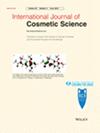Influence of particle parameters on deposition onto healthy and damaged human hair
Abstract
Objective
This research investigates how particle parameters, such as zeta potential, size, functional group, material composition, and hydrophobicity affect their affinity and deposition of particles onto hair.
Methods
Streaming potential was used as the technique for analysis. The streaming potential data obtained was then converted to surface coverage data. Scanning electron microscopy (SEM) was also done to visualize particle localization on the hair surface.
Results
This study found stronger particle affinity on healthy than on damaged (oxidatively bleached) hair, due to diminished interaction sites from the removal of the hair shaft's external lipid layer. SEM imaging supported these findings and offered insights into particle localization. Hydrophilic silica particles accumulated along the exposed hydrophilic cuticle edges of healthy hair, due to hydrogen bonding with the exposed endocuticle. This localization is hypothesized to be due to the limited hydrophilic binding sites on the hydrophobic healthy hair cuticle surface. In damaged hair, an abundance of hydrophilic sites across the cuticle surface results in more dispersed binding. Hydrogen bonding and electrostatic attraction were shown to be the predominant forces influencing deposition, with hydrophobic interactions playing a less influential role. The affinity studies also proved that electrostatic attractions work over a longer range and are more effective at lower particle conditions compared with hydrogen bonding which only start to play a bigger role at higher particle concentrations. Steric hindrance of bulky side groups acted as a significant repulsive force. Results also revealed that larger particles deposit poorly on both healthy and damaged hair compared with smaller ones. Compared with neutrally charged silica nanoparticles (SN-2), positively charged PMMA particles (PN+16) have a stronger affinity to healthy hair, with highly charged particles (PN+49) depositing most rapidly.
Conclusion
This study provides a fundamental understanding of how particle–surface parameters influence their affinity to hair and how damaging hair affects deposition.


 求助内容:
求助内容: 应助结果提醒方式:
应助结果提醒方式:


